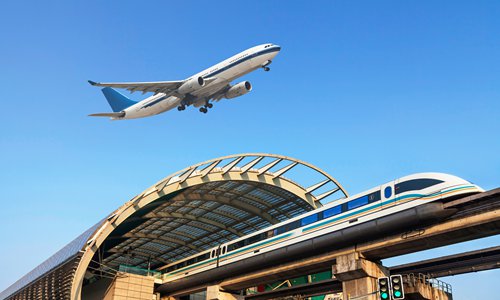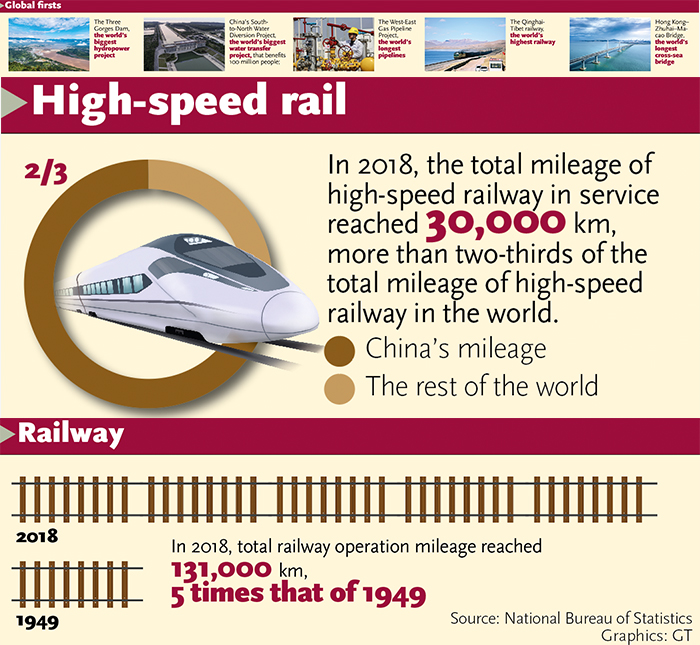HOME >> BUSINESS,SPECIAL-COVERAGE
Infrastructure has brought China forward over the last 70 years
Source:Global Times Published: 2019/9/24 17:58:40 Last Updated: 2019/9/25 23:21:49
From the chaos of 1949 to prosperity and global recognition in 2019

Photo: VCG
Editor's Note:70 years ago, when China was still in the ruins of war and buildings were waiting to be constructed, people did not expect that it would turn into an infrastructure giant so soon that is now even helping others to build bridges, ports and rails overseas.
The country did not stop at that hard-won level of achievement. Building on efforts, sweat and the innovation of millions of Chinese people, now, when new technologies such as 5G and AI are transforming the world and the way people live, the country is on its way to take the lead again in the new era. It seeks to bridge the world, and to promote joint development for the benefit of the world.
It was the development of infrastructure that dragged China forward, and it will also be infrastructure that does this in the future.

Graphics: GT
During its overall growth in the past 70 years, China's achievements in infrastructure are its most obvious and they are recognized by the world. Such achievements can easily be seen through a slew of 'world's firsts' that the country has gained over recent decades.
The Three Gorges Dam, the world's biggest hydropower project in terms of electricity production; China's South-to-North Water Diversion Project, the biggest water transfer project globally, which benefits 100 million people; the world's longest pipelines, the giant West-East Gas Pipeline project with a length of 8,704 km; the world's highest railway, The Qinghai-Tibet railway, with its highest point reaching an altitude of 5,072 m; the world's longest cross-sea bridge, the 55 km-long Hong Kong-Zhuhai-Macao Bridge; and the world's longest underwater tube tunnel at 6.7 km, to name but a few.
Notably, China also has the largest mileage of any high-speed railway in the world. By the end of 2018, the total mileage of the high-speed railway in service was 30,000 km, which accounted for more than two-thirds of the total mileage of high-speed railways in the world.
According to media reports, 2.98 billion passenger trips were made during the 40-day Spring Festival travel rush in 2019. Trips taken country-wide within one year could circle the earth seven or eight times if they were placed one after another in a line.
And that mileage is still far from fulfilling domestic demand, particularly during the holidays when people have to scramble for tickets home.
China aims to put a further 3,200 km of high-speed rail lines into operation in 2019.
Hard-earned achievements
When new China was founded in 1949, it was in chaos after decades of war. Highways, railways…the transportation infrastructure began almost entirely from scratch and developed with an astonishing speed into what can be seen today, Tian Yun, vice director of the Beijing Economic Operation Association, told the Global Times on Monday.
From 1949 to 2018, the country's transport network saw notable expansion. By the end of 2018, the total railway operation mileage reached 131,000 km, five times higher than in 1949, according to a report by the National Bureau of Statistics (NBS).
Inland waterways have expanded 72.7 percent to 127,000 km in mileage, while civil aviation flight routes surged 734 times from the figure in 1950, to 8.38 million km in 2018.
Telecom networks also reported fast expansion. The number of postal service branches increased 9.4 times over the seven decades, reaching 275,000 across the country. China's mobile broadband network users topped 1.31 billion in 2018.
Starting from almost zero to the world's major infrastructure power today, such achievements do not come from nowhere.
They were built upon the years of efforts and hard work from millions of Chinese citizens who were willing to make selfless contributions.
The CRRC Qingdao Sifang Rolling Stock Research Institute Co (CRRC SRI), which provided key technologies for Beijing's first metro train and China's first double-deck passenger train, is among the companies that made China into the major infrastructure power that it is today.
It has played an important technical supporting role in China's six large-scale railway speed-up projects, and has independently developed an air-conditioning oxygen supply system, an electrical system and air springs for Qinghai-Tibet trains, to assist Chinese trains to run safely on the "roof of the world."
"Since the founding of our company 60 years ago, we have always insisted on independent innovation, providing core systems and key products for the rail transit industry. Our many core technologies, such as traction converters, couplers and draft gear, the anti-vibration system, and TCMS, have been applied to China's Standard EMU and the 'Fuxing' EMU," the head of CRRC SRI told the Global Times on Tuesday.
"Meanwhile, we have applied technology innovation for high-speed trains to the urban rail field, which is the first time China has achieved the integration of the three systems of traction, network and braking, and on this basis has built intelligent trains."
China's infrastructure development has not slowed after the achievements that have been made thus far. In the future, with the rolling out of regional jets and domestically manufactured large aircrafts, China will usher in an upsurge in the aviation industry, including the new rail transit which has been developed and is in full swing in China, according to Tian.
"While China has built a strong infrastructure team, it has also developed its own construction machinery and equipment, which utilizes technology that is in a leading global position. China does not simply use manpower to complete bridge construction projects as we see in videos on the internet, but uses a lot of domestic and large mechanical equipment. And the quality, the technology and the cost performance are competitive around the world," Tian said.
Linking the world
With its world-leading infrastructure building capacity, China is now eyeing overseas markets in an effort to link the world with its capabilities in the sector.
"China is now the largest country receiving orders for infrastructure projects overseas, ranking first in the world for more than ten years in a row. The value of orders every year exceeds hundreds of billions of US dollars," Tian said.
The Belt and Road Initiative (BRI), proposed by China in 2013, aims to build a trade and infrastructure network connecting Asia with Europe, Africa and beyond. It is a vivid example of how China can connect the world with its infrastructure experience.
After years of unremitting effort, the BRI has seen numerous achievements. With increasing collaboration on ports, railways, highways, electricity, aviation and communications, infrastructure development along the Belt and Road has been effectively upgraded, with better-than-expected results.
Additionally, ports are better connected than other transportation facilities between China and other nations along the Belt and Road. China maintains the top worldwide ranking in maritime connectivity, with shipping routes connecting its ports to over 200 nations and 600 major ports.
As for railway connections, the cumulative number of trips made by China-Europe freight trains exceeded 12,000 in 2018, with annual shipments reaching $16 billion, compared with only 17 trips and less than $600 million in 2011.
Total trade between China and other BRI countries amounted to $6.47 trillion over the 2013-18 period. More than 80 overseas economic and trade cooperation zones were built, and more than 244,000 jobs created for locals.
Bridge to the future
Regarding the intelligent era, Tian again stressed the importance of infrastructure capacity as it also provides an important foundation for China to realize industrialization and urbanization in the future, led by information technology.
"Today, no matter whether it is China or the US, if anyone wants to reindustrialize, there is no platform to support it without technology in infrastructure," Tian said.
"We should also watch construction in the information age, including intelligent manufacturing and smart city construction, which are not the same as in the past. For example, high-speed communication [systems] like 5G, cloud computing, cloud servers, and dispersion of data stored in huge clouds, artificial simulation and artificial intelligence (AI). China has also seen good achievements in these fields of infrastructure," Tian said.
Posted in: INDUSTRIES,INSIGHT,MORE 1